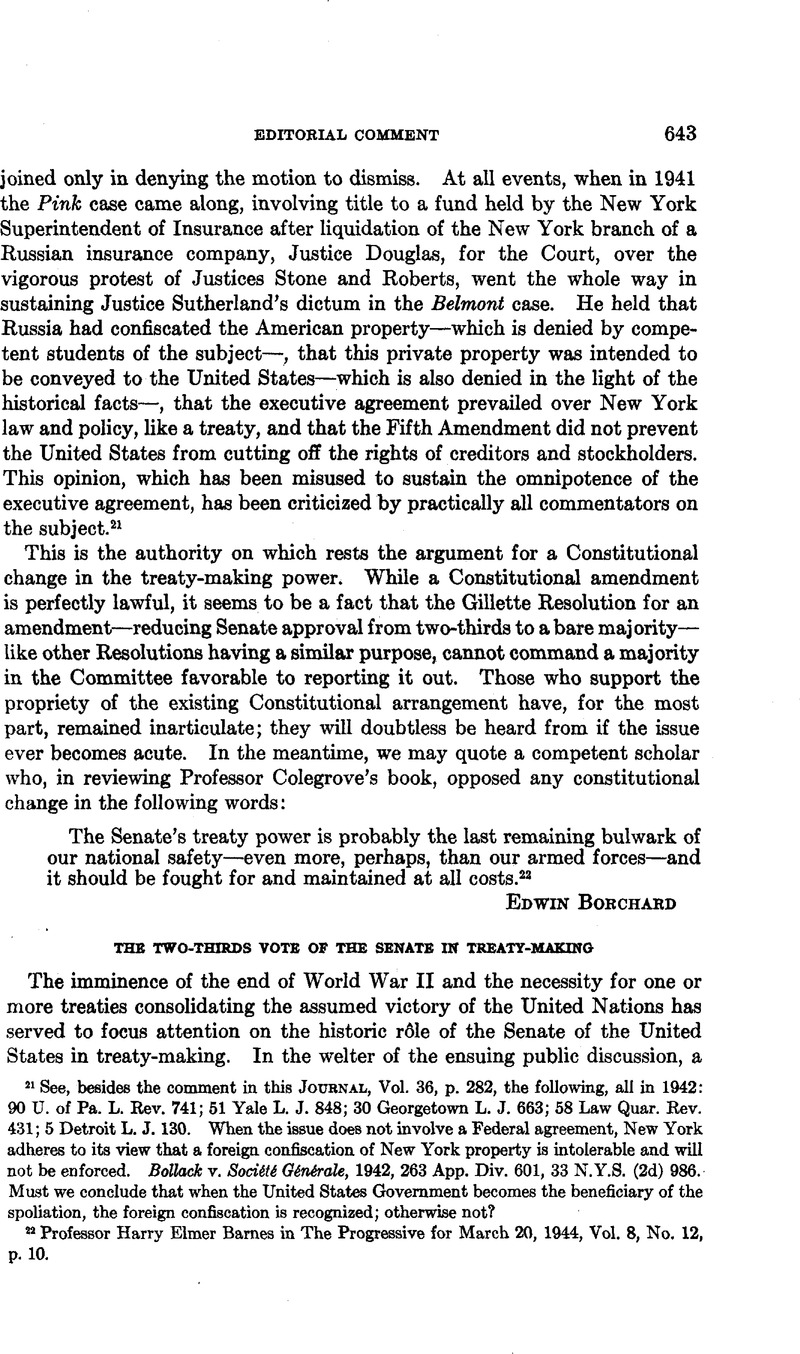No CrossRef data available.
Published online by Cambridge University Press: 25 April 2017

1 Such, for instance, as S. J. Res. 102, introduced by Senator Claude Pepper on Dec. 13, 1943, and H. J. Res. 264, introduced by Representative Sol Bloom on April 13, 1944, both of which provide for a majority concurrence of both houses of the Congress. S. J. Res. 36 and S. J. Res. 37, introduced by Senator Guy Gillette on Feb. 25, 1943, provided for a majority concurrence of the Senate alone.
2 Senator Claude Pepper, “Peace Despite the Filibusters,” New York Times Magazine, Dec. 12,1943, p. 40. This argument was pointed out by James Wilson (Pa.) in the Federal Convention of 1787: Charles C. Tansill (ed.), Documents Illustrative of the Formation of the Union of the American States, Washington, 1927, p. 685. His argument did not prevail.
3 A. Barr Comstock, Majority Vote Favored, letter to the Editor, New York Times, May 7, 1944, Sec. E, p. 8. Sometimes the argument takes the clever form of a passing reference to “the possibility of a veto by one third plus one of the Senate of the United States”: Wendell Willkie, “Cowardice at Chicago,” Collier’s, Sept. 16, 1944, p. 77.
4 Kenneth Colegrove, The American Senate and World Peace, New York, 1944, p. 13.
5 Hugh Williamson (S. C.) called attention in the Federal Convention of 1787 to the fact that even a majority of the votes in the Senate might not constitute a majority of the population. Tansill, work cited, pp. 688–689. Elbridge Gerry (Mass.) spoke of the danger of entrusting the essential rights of the Union to “so small a number as a majority of the Senate, representing perhaps not one-fifth of the people”: Tansill, work cited, p. 689. Their opinion did not prevail.
6 Finch, George A., “The Treaty of Peace with Germany in the United States Senate,” this Journal, Vol. 14 (1920), pp. 155–206 Google Scholar.
7 Herbert Wright, Things to Be Avoided, letter to the Editor, New York Times, Jan. 23, 1944, Sec. E, p. 8.
8 Samuel Flagg Bemis, A Diplomatic History of the United States, New York, 1942 (rev. ed.), p. 654.
9 Bemis, work cited, p. 655.
10 Thomas A. Bailey, A Diplomatic History of the American People, New York, 1940, p. 675.
11 Pepper, work cited.
12 Finch, work cited, pp. 156–157.
13 Herbert F. Wright, Philander Chase Knox, in Samuel F. Bemis (ed.), The American Secretaries of State and Their Diplomacy, Vol. IX, pp. 352–355.
14 Text in this Journal, Vol. 14 (1920), pp. 419–420.
15 The material in this table has been compiled from U. S. Dept. of State, List of Treaties Submitted to the Senate, 1789–1934, Washington, 1925, and succeeding supplements.
16 John B. Elliott, League May Be Revived, letter to the Editor, New York Times, Jan. 16, 1944, Sec. E, p. 8.
17 The data presented here is based upon U. S. Dept. of State, work cited.
18 “In less than a dozen of these cases can it be definitely stated that the two-thirds rule was responsible for the outright defeat of the treaty”: Wright, Quincy, “The United States and International Agreements,” this Journal, Vol. 38 (1944), p. 353 Google Scholar.
19 Elliott, work cited. Prof. Quincy Wright, work cited, p. 355, even goes so far as to say: “Not only is it legally permissible to by-pass the two-thirds rule, but it is politically practicable.”
20 Even Prof. Quincy Wright, work cited, p. 355, note 63, admits that it was “assumed” in the Federal Convention of 1787 that the President “would use the Senate as an executive council during the course of negotiations and so would be assured of its speedy consent.” See Charles C. Fausill, “The Treaty-Making Power of the Senate,” this Journal, Vol. 18 (1924), p. 461.
21 Compare the experience of Secretary William Jennings Bryan in securing the consent of the Senate to his “cooling-off” treaties, “every one of which was … advised to in advance” and some of which, by reason of the precaution which he had taken of consulting the Senate Committee on Foreign Relations, “were immediately consented to when they were submitted to the Senate in their negotiated form. ” James Brown Scott, American Society of International Law, Proceedings, 23rd Meeting, April 26, 1929, Washington, 1929, p. 171. For instance, the Senate approved the treaties with Ecuador and Greece in 7 days, with Sweden in 9 days, with France, Great Britain and Spain in 10 days and with Russia in 12 days after signature.